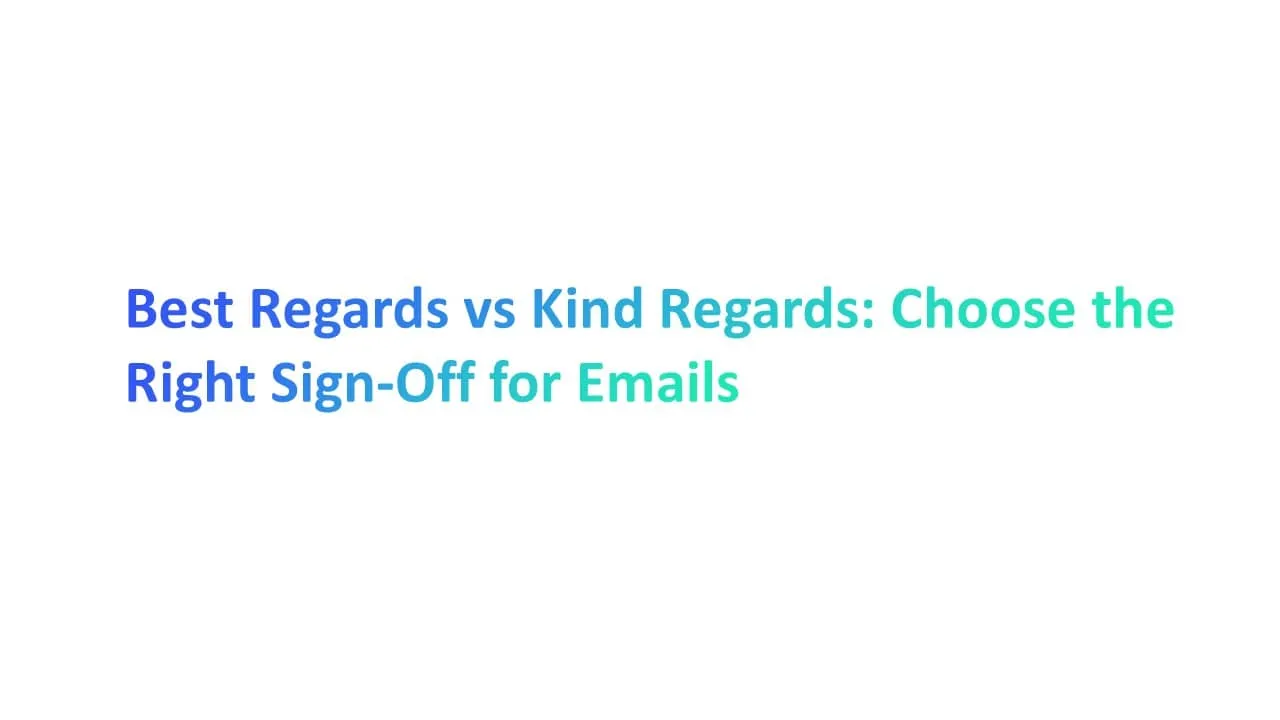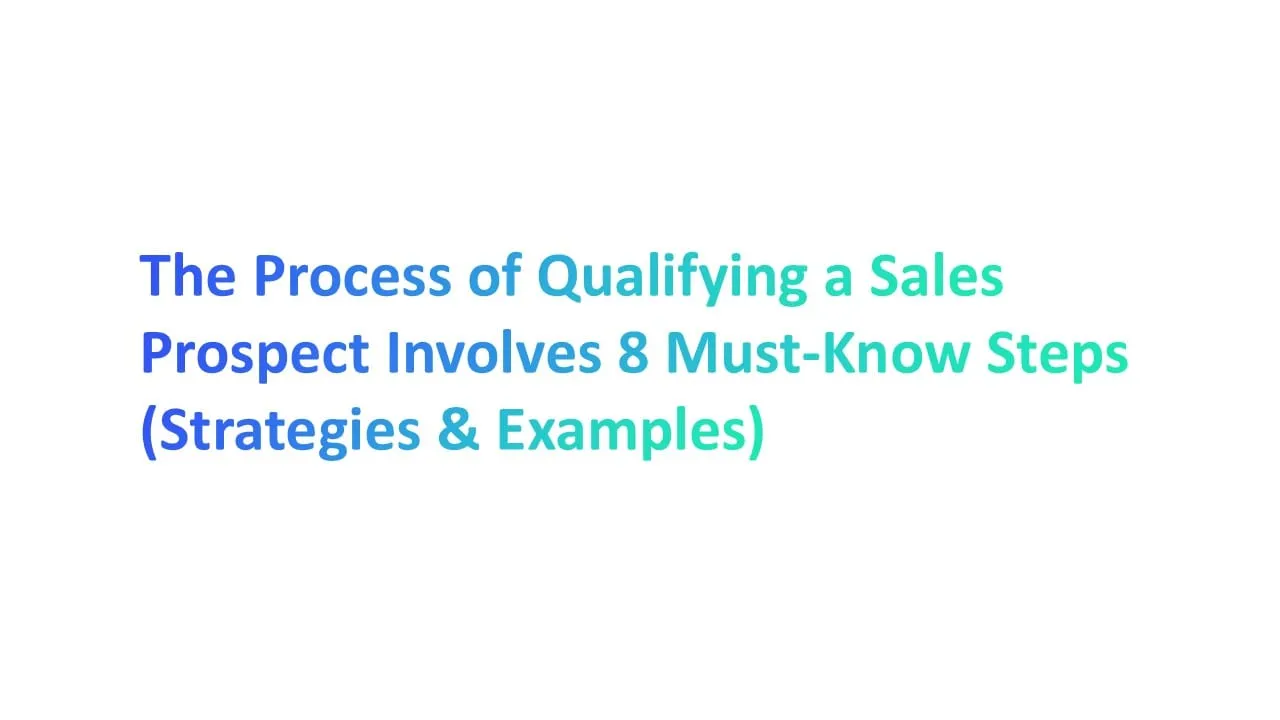You’ve nailed your email… until it’s time to sign off. Should you say Best regards or Kind regards? Believe it or not, this tiny phrase can impact how people perceive your professionalism.
In fact, a Boomerang study found that emails with a polite sign-off had a 14.5% higher response rate. That’s not small.
Whether you're writing to a potential client or your boss’s boss, the right email closing matters. This guide will help you sound sharp, respectful, and not accidentally too chill. Ready? Let’s figure out how to end emails the right way.
What Is a Sign-Off in an Email?
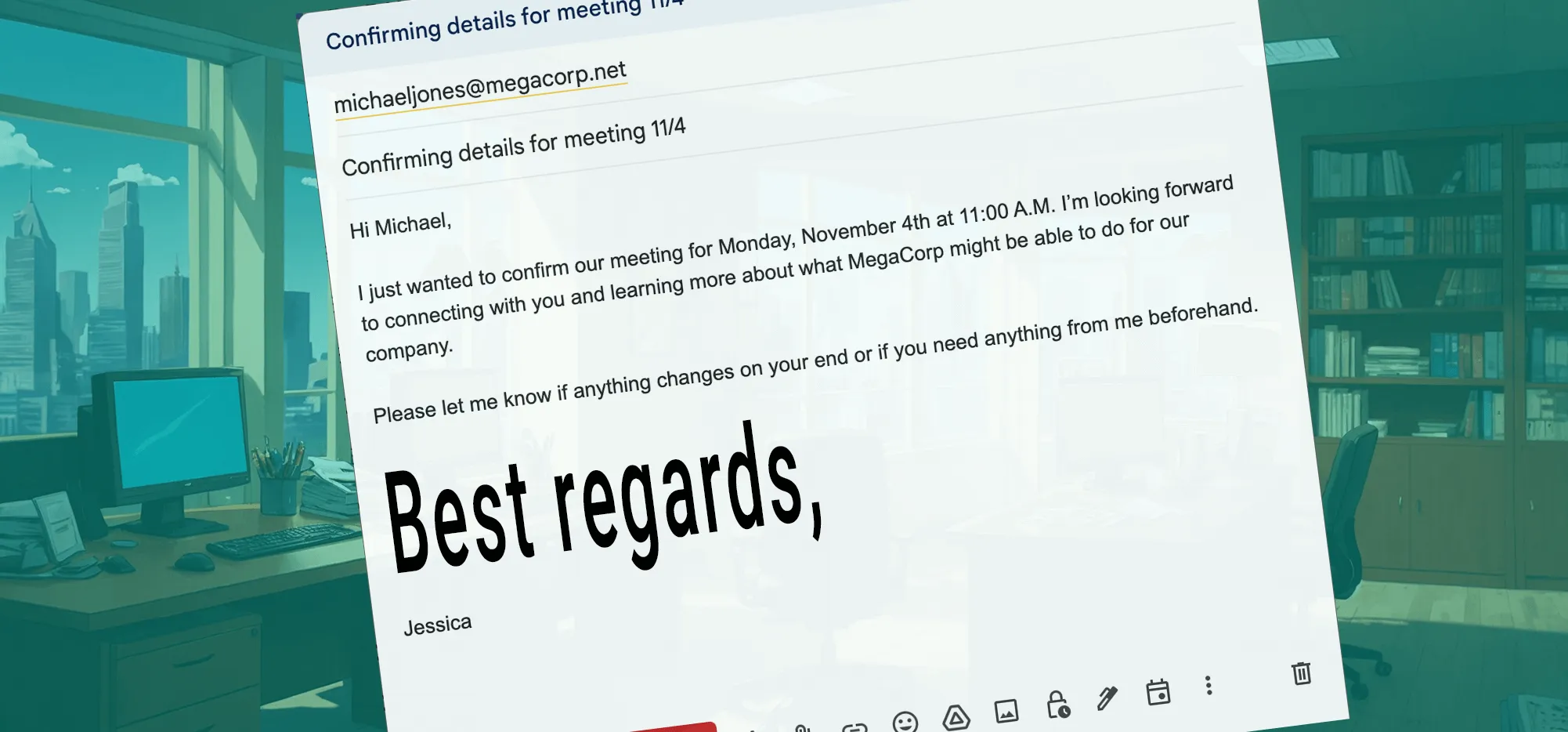
An email sign-off is the last thing you write before your name. It's also called a formal sign off or email closing. Think of it like a polite way to end your message. Simple words like Best regards, Kind regards, Warm regards, or Sincerely help set the right tone.
If you’re writing a business email or a professional email, you can’t skip this part. A good sign-off adds a final touch of professionalism.
It helps build trust, especially with a potential client or in cover letters and formal emails. The wrong sign-off could even sound rude or too overly formal.
Why Your Email Sign-Offs Matter
Let’s say you're sending an email to your boss, a colleague, or someone in a professional setting. Should you use Best regards or Kind regards?
Here’s why the choice matters:
- Best regards works well in most professional correspondence. It’s safe, respectful, and clear.
- Kind regards feels a little warmer. It's nice if you already have a friendly relationship or want to add a personal touch.
- Studies show that the right email sign offs can boost replies by over 14% (Boomerang, 2022).
- Your sign-off can leave a lasting impression and show you know how to write with professional tone.
Quick tip: In a formal letter or business letter, stick with Sincerely or Best regards. They’re polite, simple, and work in almost every formal setting.
Best Regards vs Kind Regards: What’s the Real Difference?
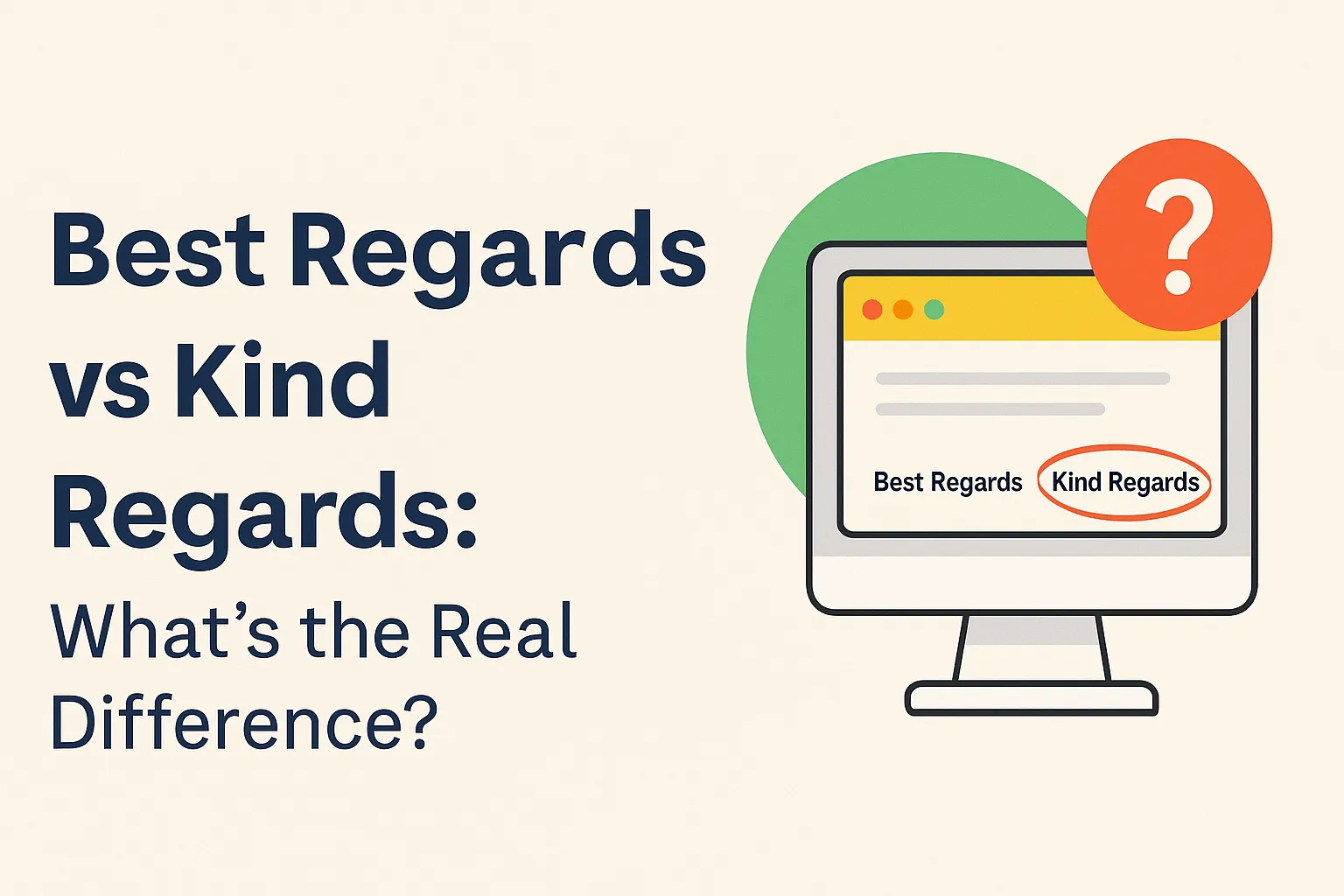
What Does “Best Regards” Mean?
“Best regards” is one of the most common email sign offs in a business setting. It’s friendly, but still professional. You’ll see it a lot in cover letters, formal emails, or when reaching out to someone for the first time.
How to Use “Best Regards” in Emails:
- You write a business email to someone new, maybe a potential client or your boss.
- You send an email that needs to be serious or more formal, like cover letters or formal emails.
- You want to keep your message professional, without extra emotion.
Example:
Hi Jordan,
I’ve attached the report for your review. Let me know if you have any questions.
Best regards,
Maria Thomas
It works great when you want to leave the door open for more conversation but keep things polite.
What Does “Kind Regards” Mean?
“Kind regards” is similar to Best regards, but it’s a little warmer. It feels more relaxed and adds a bit of a personal touch—especially if you already have a friendly relationship with the other party, like a teammate or someone you’ve emailed before.
How to Use “Kind Regards” in Emails:
- You write to your colleagues or someone you have emailed before.
- You share good news or say thank you in a friendly way.
- You want your message to sound polite but warmer and less strict.
Example:
Hey Melissa,
Thanks again for the feedback on the design mockup! Looking forward to working on the next round.
Kind regards,
Leo Chang
It’s perfect when you want to show warmth and kindness in a professional or business setting.
Study Snapshot: Which Sign-Off Actually Gets More Responses?
Did you know your email closing can make all the difference in getting replies? A study by Boomerang analyzed over 350,000 emails. They found common email sign offs like "best regards" and "kind regards" boost reply rates. But which is better?
- "Best regards" had a response rate of 51.2%. It works best in formal situations or when emailing a potential client for the first time.
- "Kind regards" got slightly more replies—around 53.9%. It's better if you have a more friendly relationship, like writing to colleagues or close friends.
Choosing the right word choice truly shows respect and sets a positive, respectful tone.
How Email Sign-Offs Shape Business Communication
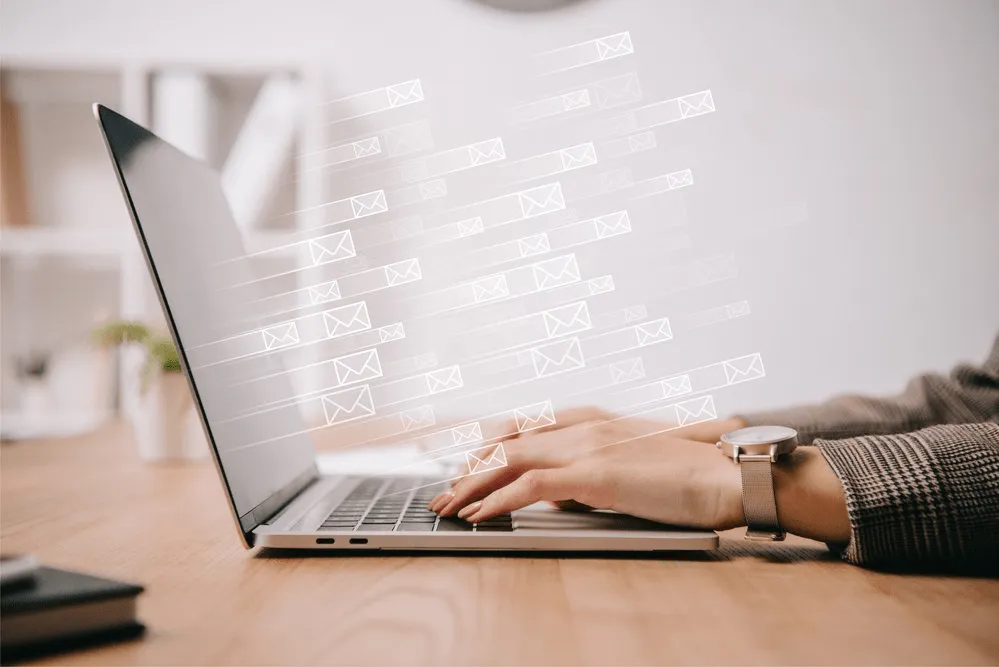
1. They Signal Professionalism Instantly
When you write a business email, people notice how you end it. A clear, respectful sign-off—like best regards—shows you’re serious and professional. If you're reaching out to a potential client or sending a cover letter, your sign-off can help you sound trustworthy.
Even something as small as using a more formal sign off can impact whether someone replies or not. According to a Boomerang study, emails with polite sign-offs get more responses.
2. They Match and Reflect the Email’s Overall Tone
Your sign-off should match the feeling of your email. If your message is formal, use something like sincerely or best wishes. If it’s casual but still polite, kind regards or warm regards works well—especially if you're writing to colleagues, friends, or someone you already know.
Your word choice affects how the other party feels. A mismatch—like using best regards in a very personal letter—can feel cold. And using cheers in a formal letter might sound too casual or even sound rude.
3. They Set the Stage for Ongoing Communication
A good email closing keeps the door open. It says, "Let’s keep talking." Whether you're discussing ongoing projects or starting a conversation with a new company, choosing the right sign-off helps build trust.
In fact, thoughtful email signatures and polite endings show respect. They help your message leave a lasting impression. This is especially true in professional or formal settings, where tone and style matter most.
4. They Influence How Your Message Is Perceived
The sign-off you use changes how the other party sees your tone. For example:
- Best regards feels clean and formal.
- Kind regards adds extra warmth and feels more personal.
If you're writing a personal letter, use something softer. For a business email, stick to a more formal sign off.
The wrong choice can sound rude even if you didn’t mean it. The right one builds respect and keeps the conversation going.
5. They Are Culturally Important in Global Settings
In the U.S., best wishes or kind regards are common. But in other countries, those may feel too casual—or too stiff.
Here’s a quick tip:
- When sending emails across cultures or borders, always aim for a polite sign off.
- In British English, for example, kind regards is used more often than in American companies.
If you're unsure, ask a colleague or do a quick check online. This shows you respect cultural differences, and that matters.
6. They’re Part of Your Professional Brand
Your email style is part of your brand—even your email signatures.
- Are you working for a modern company? You might go with warm regards.
- Are you in a legal or formal industry? Sincerely or best regards might fit better.
Whatever you pick, stay consistent. Your sign off should match your tone, job, and audience. When someone sees your name in their inbox, the sign off can make them trust you—or not.
So yes, a tiny phrase like regards vs kind really can make all the difference.
Complete Guide to Choosing the Right Email Signatures (When to Use Them)

Choosing the right email signatures may seem small, but it can make all the difference in your message. It shows how professional, warm, or friendly you want to sound. Whether you're emailing a company, a colleague, or a potential client, your sign off matters.
1. Best Regards
Best regards is a great pick for most professional settings. It's safe, polite, and works in many situations.
When to use “Best Regards”:
- In a business email with someone you don’t know well.
- When talking to clients or someone from another company.
- In follow up emails or job applications.
Why it works:
- It gives a formal closing without sounding cold.
- It’s common in American and British email sign offs.
- It keeps the conversation respectful and clear.
Example: “Thanks again for your time. Best regards, Emily.” This keeps your message serious, but friendly.
2. Kind Regards
Kind regards sounds a little more gentle. It adds a personal touch, while staying professional.
When to use “Kind Regards”:
- When writing to someone you already know.
- If the conversation has been warm or supportive.
- When writing to colleagues or friendly clients.
Why it’s great:
- It’s polite and soft.
- Good for situations that need a relaxed tone.
- Helps build a friendly relationship.
Example: “Looking forward to our next call. Kind regards, Jason.” This feels warm but still fits a professional email.
3. Warm Regards
“Warm regards” adds a little extra friendliness to your email. It’s not as formal as “Sincerely” or “Best regards,” but it still sounds polite and professional. It’s a good sign-off when you want your message to feel personal but not too casual.
Use "Warm regards" when:
- You’ve already had friendly conversations with the other party.
- You’re talking to a potential client you’ve spoken to before.
- You want to close with a more personal touch, especially in a professional setting.
This sign-off works well in follow up emails, especially after meetings or thank-you notes. But be careful—if you're writing a business email in a formal setting, “Warm regards” might sound too relaxed.
Quick Tip: In global business communication, some cultures see “warm” language as too familiar. Always consider who’s receiving the email.
4. Sincerely
“Sincerely” is one of the most common email sign offs in the professional world. It’s a formal sign off that works great when you’re writing a business letter or applying for jobs.
Use "Sincerely" when:
- You're writing a cover letter or reaching out to a professional contact for the first time.
- You want to show respect in a serious or formal conversation.
- You want to keep the tone safe and universal in any professional or business setting.
Compared to warm regards, “Sincerely” has less emotion but more structure. If you're unsure what to use in best regards vs kind regards situations, “Sincerely” is often a safer choice in formal emails.
Study Snapshot: According to Boomerang, emails ending with a professional closing like “Sincerely” or “Best regards” get more responses than those with no sign-off at all. That alone can save time and boost replies.
5. Best Wishes
"Best Wishes" is a warm sign-off often used in friendly or semi-formal emails. It works great when you want to sound polite but not too stiff. People often choose it to end conversations with a positive feeling—especially when writing to someone they already know.
This sign-off fits well in both personal emails and light business communication. For example, you might use it in a note to a colleague about a birthday, a farewell, or after a friendly email conversation with a potential client.
Here's when "Best Wishes" is a good choice:
- You have a friendly relationship with the other party
- You’re writing a personal letter or cover letter
- The email has a relaxed tone but still needs a professional sign-off
Example:
"Thanks again for all your help last week. Hope your new project goes smoothly.
Best wishes,
Emma"
"Best wishes" isn’t too formal or too casual. It sits right in the middle—making it a safe, friendly option that leaves a lasting impression without sounding overly formal.
Pro Tip: Don't use "Best Wishes" if you're emailing someone for the first time communication in a serious business setting. In that case, go with best regards or sincerely.
Common Mistakes People Make with Email Closing
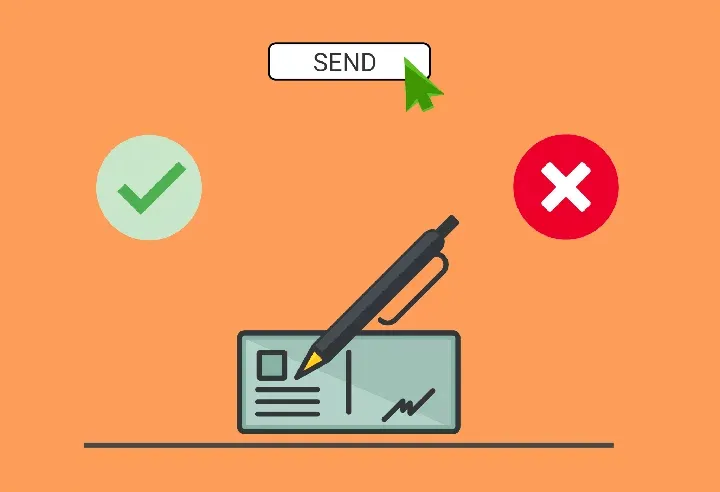
1. Using the Wrong Tone for the Situation
One big mistake is not matching your sign-off to the email's tone. Imagine ending a serious business email with “Cheers” or “Later.” It feels odd, right? You might be wondering: Should I use “best regards” or “kind regards”?
Here’s a quick tip:
- Use best regards when you want to sound more professional.
- Use kind regards when you want a warmer, softer touch.
But don’t mix it up. For example, using kind regards in a legal business letter might feel too relaxed. On the flip side, ending a thank-you note to a close friend with best regards can sound stiff.
Always match the email closing with how formal or casual the message is.
2. Being Too Overly Formal (Or Too Cold)
It’s great to sound professional—but being too stiff can also backfire. Sign-offs like “Yours faithfully” or “With deepest sincerity” might feel too heavy for a quick work update. Even “best regards vs kind regards” can sound cold if the rest of the email feels friendly.
Ask yourself:
- “Would I say this out loud?”
- “Does this fit the tone of the conversation?”
Sometimes, regards and kind sign-offs are overused and lose meaning. Try adding a personal touch or switching it up based on who you’re writing to.
3. Using a Personal Tone in a Professional Email
It’s easy to slip into “texting style” when writing emails. But a professional email shouldn’t end with “Cheers” or “XOXO.”
- If you're writing to your boss, client, or a potential client, choose a formal sign-off like Best regards or Sincerely.
- Use Kind regards when you want to sound warm but still polite.
Tip: Never confuse personal emails with business ones. The wrong tone in your email closing can make you seem unprofessional.
4. Overloading or Underusing Your Email Signature
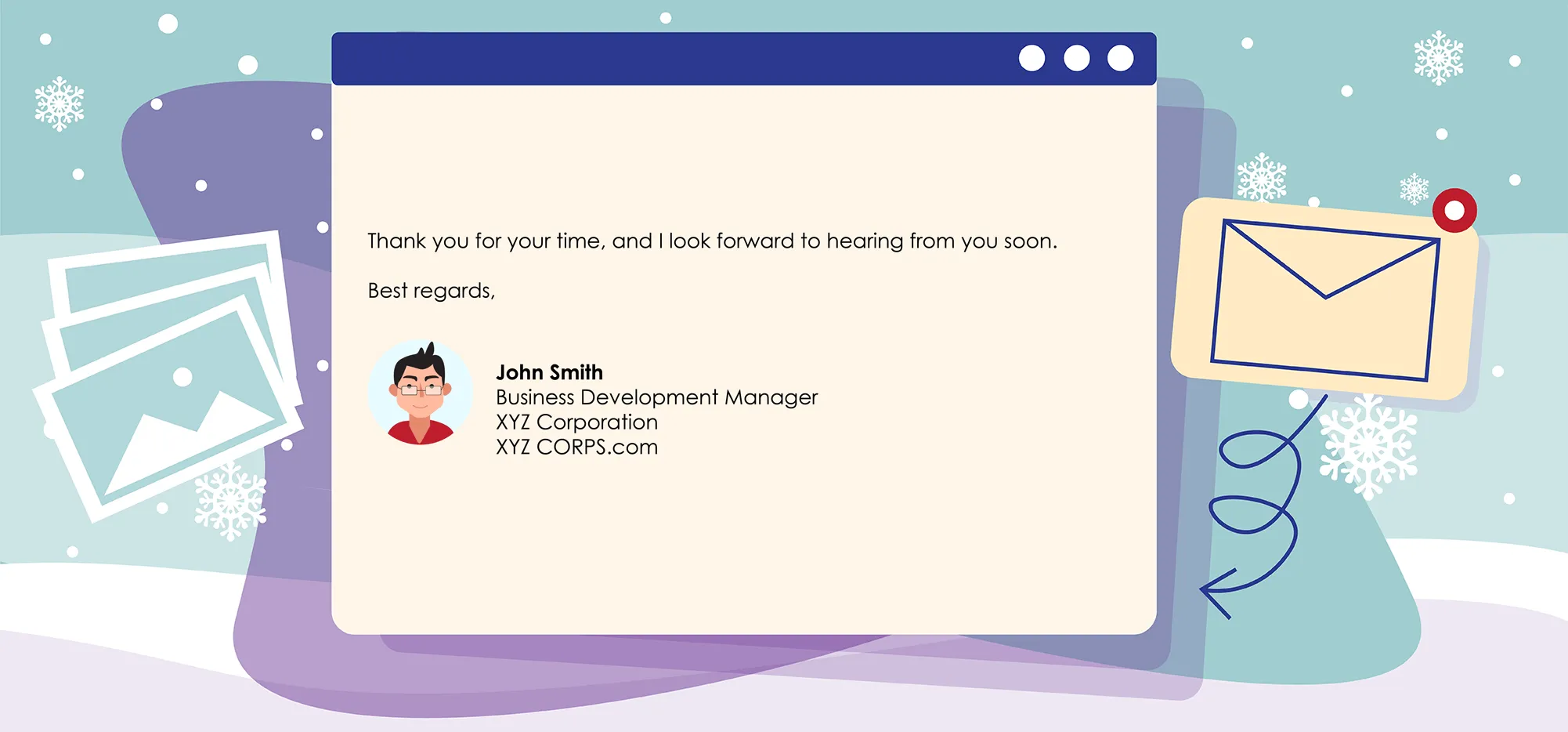
Your email signature is not the place for your life story. But it also shouldn’t be empty.
- Too much info can overwhelm the reader.
- No info makes it hard for them to know who you are.
Stick to this:
- Your name
- Job title
- Company name
- Contact info
Keep your email sign-off short and clear. You can say Best regards vs Kind regards — both are safe picks in a professional setting.
5. Not Considering Cultural Norms
Email style isn’t the same everywhere. Some cultures prefer very formal closings. Others are more relaxed. For example:
- In Japan or Germany, Sincerely or Respectfully might work better.
- In the U.S. or UK, Best wishes or Kind regards are more common.
When you send emails across countries, pick a closing that feels respectful. Using the wrong one may sound overly formal or even rude.
Choosing between best regards vs kind regards may feel small—but it says a lot. The right sign-off leaves a lasting impression, shows respect, and fits your tone. Whether you want to sound warm, formal, or professional, pick a closing that matches your message and your relationship with the reader. A little word choice makes all the difference.

